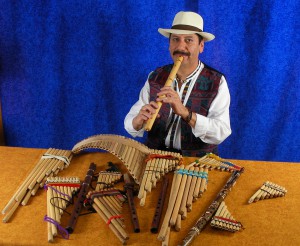Music from South America

Enter text here
About:Music from South America forms the heart of South American culture and traditions. Music in South America originated in the Andes. The present picture of South American music is colored by the natives of South America, the Spanish and the Africans who came to South America as slaves. Music in South America has also had the influence of Roman Catholicism.
In South America music makes up the daily lives of the people. There is music for everything such as agricultural labor, building houses, funerals, marketing cattle, sheep and goats etc. There are also a number of traditional dances and traditional dance songs in South America. The region in and around Andes including the countries of Peru, Bolivia, Argentina and Chile have a diverse range of musical traditions. The traditional music of Andes is called Huayno which is popular for its use of pan flutes.
The lyrics are in Spanish and Quechua. The songs have various subjects like earth, seasons, harvest time, love, family, children, and stars. The instruments used in South American music are pan pipes, flutes, rattles, guitar, a native guitar-charango and the drum. The rhythms speak of the African influence on South American music. Valses (waltzes) though have a European origin have emerged in a unique manner in Peru. The famous Salsa music is again a cultural characteristic of Peru. Other popular South American dances and dance songs include Carmen Miranda, the Bossa Nova, and the Lambada.
Soca is a musical form prevalent in the Caribbean region. It is dance music with a one-two beat. Sung in English it is a mixture of soul and calypso. Tango form the most famous dance and song of Argentina. Immigration of people from Europe along with a cultural amalgamation gave rise to the Tango. Incorporating a particular language, customs and usage and a certain philosophy, Tango is much more than just music. 1
Similarities to other music styles: Spain inspired much of South and Central American folk music. However, indigenous folk music, such as that of the Inca in Cuzco, Peru, plays a role as well.2
Influences: Latin American music, found within Central and South America, is a series of musical styles and genres that mixes influences from Spanish, African and indigenous sources.
DISCOVER MORE
Article from Nat Geo Music on South American Music
The cultural and musical history of South America, in its broadest outlines, is the same story repeated all over the Americas: the collision and collusion of European, African and indigenous peoples to form a new, hybrid society. But if the story is a familiar one, its details are very different, giving South America a unique and rich cultural flavor all its own. The continent’s best-known musical exports-tango, samba, bossa nova-are all products of this hybrid experience.
Unlike North America and the Caribbean, where various European colonial powers vied for supremacy, South America remained amicably split between the Portuguese and Spanish crowns by a 1493 decree of Pope Alexander VI-who failed to consult with the indigenous peoples already living there. This opened the door for the bloody conquest of the continent by European armies: most notably Francisco Pissaro’s successful assault on the Incan empire on the Pacific coast. First contact was invariably a one-sided affair, with European military technology and microbes decimating native populations wholesale. There are no records of the number of people living in the Americas before 1491-and estimates vary wildly-but it’s broadly accepted that populations fell sharply and sophisticated cultures faltered in the wake of European encroachment.
Wholesale colonization followed, and many of the remaining native peoples were forced into indentured servitude or enslaved outright. But in the 16th century, the cultivation of sugar soon proved more profitable than gold in Northern Brazil and other parts of the Caribbean basin, and African slaves began arriving by the boatload to provide the labor force. Brazil would continue to import hundreds of thousands of slaves-particularly from Angola-until 1888, when it was the last nation in the Western hemisphere to abolish slavery. Today in Brazil, people of African ancestry outnumber those of European and indigenous ancestry combined.
The Spanish/Portuguese linguistic division persisted long after Portugal and Spain gave up their colonies, and their languages lent a unique cohesion to the mosaic of cultures and peoples of South America. Even the relatively recent immigrants of the 19th, 20th and 21st centuries-Germans, Italians and even Japanese-have assimilated linguistically. For more than 500 years, these disparate cultures recombined to form vigorous new hybrid cultures, known variously as Creole, criollo, crioulo or mestizo. In most of South America, this hybrid has long been the dominant culture-whether a realization of the Bolivarian dream of an independent continent or simply reflective of demographic realities. And because of the constant cross-fertilization of musical know-how, South America is a treasure trove of Creole musical styles.
Brazil alone is one of the world’s great musical powerhouses, boasting everything from samba, bossa nova and the world famous Carnival troupes, to lesser-known styles such as forro, choro and the myriad pop sounds of MPB, or Música Popular Brasileira. While Argentina is the home of not only tango but also zamba, milonga and chamamé. Colombia and Venezuela are musical universes of their own, where the joropos and llaneros of the high-plains cowboys gives way to the simmering coastal sounds of vallenato, cumbia and currulao. Even tiny Uruguay boasts a unique national style called candomble. While on the other side of the Andes, the music of Boliva, Chile, Peru and Ecuador reflects their larger indigenous populations, and such styles as huayno, yaraví and cueca all retain strong precontact musical elements. At the same time, these countries, along with Argentina, were the crucible of the nueva cancion movement of the 1970s, which mixed Andean themes and sounds with very contemporary calls for social justice.
Of course pop music is important across the continent, and international pop, R&B, hip-hop and dance music are all immensely popular thanks to MTV’s Latin American division. But homegrown pop-especially rock en Espanol-has been equally important in recent years, and bands such as Argentina’s Los Fabulosos Cadillacs and Colombia’s Los Aterciopelados have won worldwide followings. -Tom Pryor 3
VIDEOS
History of Salsa Music
Salsa Music
Samba
African Influence on Latin Music
Source:
1.South American Music, Maps of the World: http://www.mapsofworld.com/south-america/culture/music.html
2.The Influence of Spain: Folk Music of Central and South America | Suite101.com http://www.suite101.com/content/the-influence-of-spanish-folk-music-on-the-music-of-south-america-a257944#ixzz1TzXXjXIU
3.http://worldmusic.nationalgeographic.com/view/page.basic/region/content.region/
south_america_6/en_US









